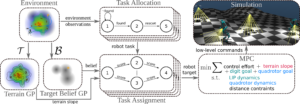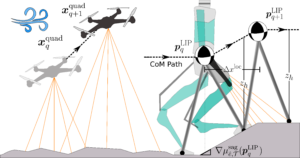
Overview:
Search and rescue missions require robotic systems capable of navigating challenging environments with complex terrains. This research introduces a framework that integrates terrain-aware Model Predictive Control (MPC) for coordinating a heterogeneous team of bipedal and aerial robots. The framework focuses on terrain-adaptive path planning, multi-robot task allocation, and real-time rescue operations.
Key Research Goals:
1. Terrain-Adaptive Navigation: Enable bipedal robots to traverse rough terrains using learned terrain models.
2. Task Allocation and Coordination: Develop dynamic task assignment strategies based on robots’ capabilities.
3. Real-Time Search and Rescue Execution: Integrate search, mapping, and rescue tasks into a single operational framework.
Methodology:
1. Terrain-Aware Model Predictive Control (MPC):
– Gaussian Process (GP) Terrain Mapping: Elevation data is modeled using Gaussian processes, providing continuous terrain predictions.
– Cost Function Design: The MPC minimizes terrain slopes, ensuring stability and safe navigation.
– Path Optimization: Both bipedal and aerial robots plan paths based on terrain predictions and task goals.
2. Task and Motion Planning:
– Multi-Robot Task Allocation: Task assignment is performed using a combination of auction and consensus-based algorithms.
– Syntactically Co-safe Linear Temporal Logic (scLTL): Ensures high-level task completion with formal correctness guarantees.
– Markov Decision Process (MDP): Plans optimal task assignments based on real-time environmental feedback.
3. Search and Rescue Framework:
– Search Task: Robots explore unknown terrain while updating the environment map.
– Rescue Task: Bipedal robots transport rescue subjects, assisted by quadrotors for mapping and obstacle detection.
– Mapping Task: Quadrotors map the environment and provide real-time terrain updates.
Experimental Validation:
– Simulations: Conducted in complex, uncertain environments with varied terrain and randomized rescue subject placements.
– Metrics Evaluated: Task completion efficiency, robot coordination accuracy, terrain traversability, and system robustness.
Key Findings:
– Improved Traversability: Robots successfully navigated uneven terrain using terrain-aware path planning.
– Dynamic Task Allocation: The system effectively managed dynamic task assignments, ensuring mission completion.
– Rescue Success: Demonstrated successful execution of search and rescue missions in challenging simulation environments.
Future Work:
– Implement real-world testing with actual robot hardware.
– Expand task specification capabilities beyond search and rescue scenarios.
This research demonstrates how integrating terrain-aware MPC, multi-robot task allocation, and advanced search and rescue strategies can enable efficient, adaptive robotic coordination in challenging environments.
Representative publications:
Abdulaziz Shamsah, Jesse Jiang, Ziwon Yoon, Samuel Coogan, and Ye Zhao. Terrain-Aware Model Predictive Control of Heterogeneous Bipedal and Aerial Robot Coordination for Search and Rescue Tasks, Submitted, 2024. [pdf] [video]
